Stories
Hills Hats
1875-
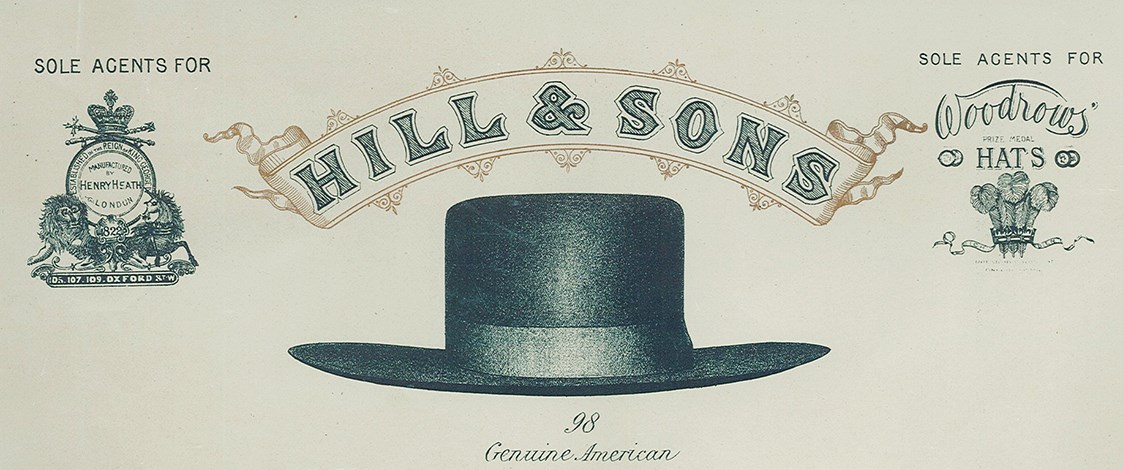
Historic machinery and a hatted hero are an unlikely combination for success in the international market but the recipe has worked wonders for a small hat manufacturer in Petone, Wellington.
Hills Hats is a Wellington story. It begins in 1875 when Chas Hill arrived in the city and established Hill and Sons, Men’s Hatters on Lambton Quay. Chas had immigrated from Bristol in England where he had worked in the hat industry. Settling in Wellington, the seat of government, he was quick to realise that the political populace were ideal customers for high-end hats.
Brochure from 1897 advertising imported hats at Hill and Sons.
Hill and Sons offered an extensive range of hats from well-established hatters in the United Kingdom and the United States. A brochure from 1897 advertised: "We are in receipt of regular shipments of Hats from the following High-Class Makers: Christy and Co., Stetson and Co., Tress and Co …" These hatters manufactured top hats, bowlers, homburgs, tweed caps and hand woven straws for Chas under the Hill and Sons brand. Chas also began to make his own hats, which were sold alongside the imported ranges.
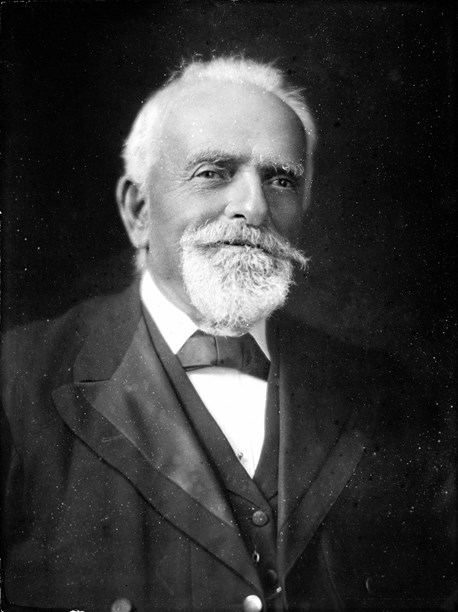
Portrait of Chas Hill.
It was not only the gentry that Chas hatted, but also local sports clubs, fire brigades and hotel and train porters. The business flourished and they opened two more shops, in Napier and Nelson.

Hill and Sons on Lambton Quay, Wellington.
Chas’ son and grandson also worked at Hill and Sons until the mid-1950s when they sold the business to a Dutch immigrant, Harry de Krey.
The new owner changed the company’s name to Hill's Headwear and moved it from Lambton Quay to Porirua. His timing however was inopportune. Formality in dress was becoming more relaxed and led to a rapid decline in the wearing of hats. Despite diversifying the business into high quality workwear, uniforms and casual hats, including blue berets for the United Nations, it was not enough and in 1997 the company was in put into receivership.
The business assets were purchased by Pieter Smuts-Kennedy whose father Bryan had established the Neck Ties manufacturing business at the end of WWII. Ties, dressing gowns and other accessories were manufactured under the Neck Ties and Eskay labels at factories in Masterton, and also Petone where they set up the newly purchased hat-making equipment.

Pieter Smuts-Kennedy.
Pieter approached his son Simon about running the business, now called Hills Hats. As a ski shop owner in Ohakune, Simon had no interest in the family business until the eruptions of Mt Ruapehu began to seriously affect his business. The offer to join his father at 'Hills Hats' was immediately accepted and the task of re-building the hat business commenced.
Many of the Hills Headwear staff stayed with the business after the ownership change. Mike Mexted, who had left school at 14 to join Hills, became the factory manager. Mike’s encyclopaedic knowledge of hat styles, patterns, eras, suppliers, materials and how to put it all together was vital in the early years. Simon says Mike held together a team of skilled and dedicated hatters who could see a potential new lease of life in the company.
Bruce McQueen was a head blocker at Treister Hats and joined Hills Hats not long after the Smuts-Kennedys purchased the business. Bruce’s knowledge and craft was instrumental to the move into fine felt blocking, which opened up the offering of top hats, homburgs, and later the uniform hats; the mounted rifle and the lemon squeezer.
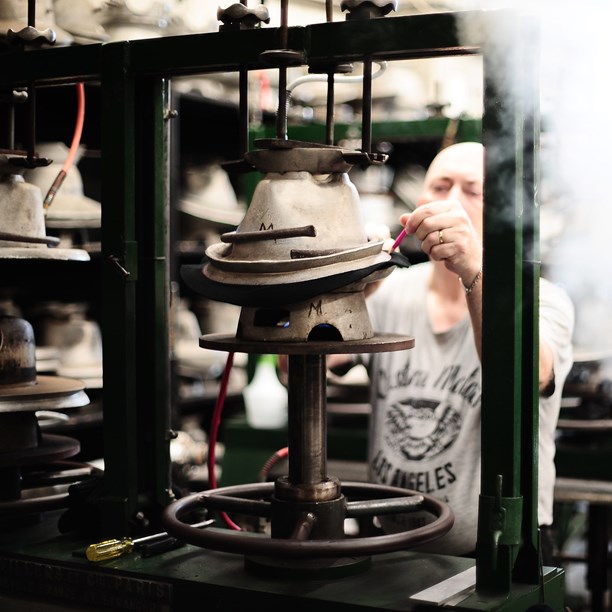
David Ruddick steaming a felt hat into shape. Image © Hills Hats.
Simon says he was "a sponge" for all this knowledge. "With both Mike and Bruce under the same roof, history was in the making and it was not long before the company made up for lost ground," he says. But it was the acquisition of the Hat Factory’s machinery in Auckland a few years later that really changed the dynamics of Hill’s drive to the future. The Hat Factory, which had previously purchased Treister Hats in Wellington, had French gas presses, hydraulic machines and a hatter’s dream collection of wooden and aluminium blocks. A lot of this specialist equipment was in disrepair but the Smuts-Kennedys slowly re-engineered the machinery and installed it their Petone factory, known fondly as 'The Hatmosphere'.
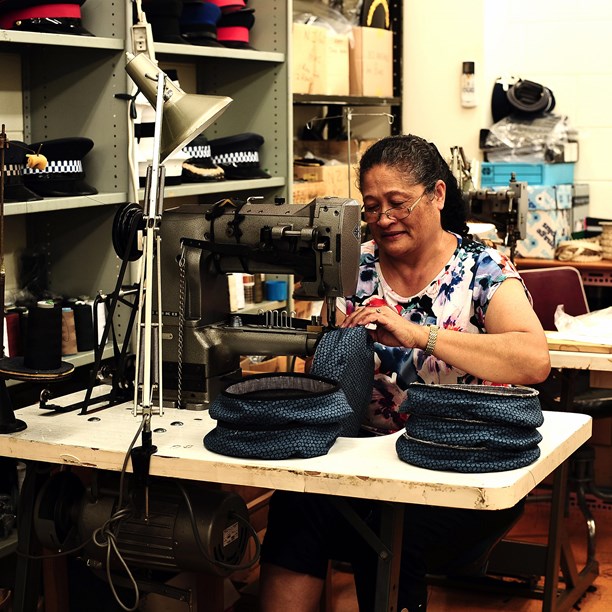
Fia Matagi, uniform department manager at Hills Hats. Image © Hills Hats.
As many businesses struggled with the flood of cheaper overseas-made product, Hills focused on supplying high end hat specialist shops around the World. Simon started knocking on doors throughout Australia, the United States and the United Kingdom. Hills now also exports into Japan under the Hills label, as well as a luxury ladies hat brand.
Simon Smuts-Kennedy talking about the design and craftsmanship that goes into the creation of a Hills hat.
The All Blacks, Black Caps and other sporting teams wear specially made hats and caps by Hills. Most of New Zealand’s uniform hats - including Air New Zealand, the police, fire service, armed services and St John’s Ambulance - are made by Hills Hats. Simon told Radio NZ in 2015 that Anzac Day is an occasion for his staff of 28 to be proud. "It’s basically a Hills Hats parade."
Hills Hats have been worn by local musicians and performers - Fat Freddy’s Drop, Shapeshifter, Ladi6, Lord Echo have all performed wearing Hills here and abroad.Guns 'n' Roses’ Duff McKagan wore a Hills Hat bowler for his Wellington concert in 2017.
The performing arts and film industry have commissioned Hills to recreate or invent new styles; and they are increasingly collaborating to create hats. Projects underway include with Goorin Brothers in the United States, CA4LA and Kollab in Japan, Pacific Brim in Australia and Otsumagic and M A D Māori Art Design in New Zealand.
Simon channels his dedication to the hat as his alter ego, The Hatman. When he leaves The Hatmosphere to promote the label, Simon dons a hat, superhero mask and hat-print suit. Hatman has his own Instagram account, @hatmanaway, which has quickly built a following since its launch in April 2018.
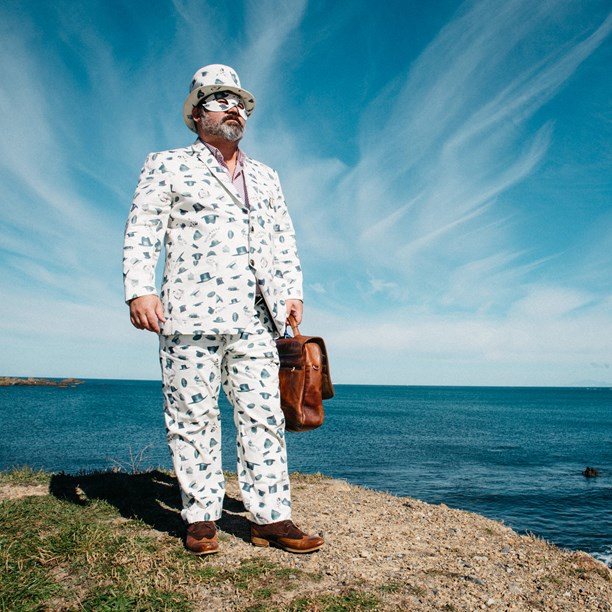
Simon Smuts-Kennedy, AKA The Hatman. Image © Hills Hats.
Pieter and Simon consider themselves as caretakers of a wonderful New Zealand institution, which together with the Eskay brand, has employed and dressed generations of New Zealanders. It’s been 20 years since Simon Smuts-Kennedy took up the challenge of reinventing a century-old business. Deploying heritage knowledge and machinery and combining it with a sense of fun and humour, has made wearing a well-made, stylish hat appealing for a new generation.
Text by Kelly Dix.
Last published September 2018.